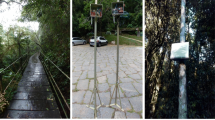Abstract
This paper presents path loss measurements at 2.1 GHz in forest and urban areas. Empirical path loss models have been presented for low-height dual-mobility channels. Three test scenarios are considered for the transmitter (Tx) and receiver (Rx) placed inside the test vehicle or on a test cart pushed at walking speed. Based on measurements, the in-leaf and single-slope path loss models are presented. The path loss exponents for the dual-mobility channels are found to be between 2.1 and 3.4 in urban and 8.0 in forest, with higher reference when antennas are placed inside the vehicle.








Similar content being viewed by others
References
Sen, I., & Matolak, D. (2008). Vehicle-vehicle channel models for the 5-GHz band. IEEE Transactions on Intelligent Transportation Systems, 9(2), 235–245.
Paier, A., Karedal, J., Czink, N., Dumard, C., Zemen, T., Tufvesson, F., et al. (2009). Characterization of vehicle-to-vehicle radio channels from measurements at 5.2 GHz. Wireless Personal Communications, 50(1), 19–32.
Iwai, H., & Goto, S. (2011). Multipath delay profile models for ITS in 700 MHz band. In Proceedings of IEEE Vehicular Technology Conference (pp. 1–5). Kyoto, Japan.
Rappaport, T. S. (2001). Wireless communications: Principles and practice (2nd ed.). Upper Saddle River: Prentice Hall.
Mecklenbrauker, C. F., Molisch, A. F., Karedal, J., Tufvesson, F., Paier, A., Bernado, L., et al. (2011). Vehicular channel characterization and its implications for wireless system design and performance. Proceedings of the IEEE, 99(7), 1189–1212.
Karedal, J., Czink, N., Paier, A., Tufvesson, F., & Molisch, A. F. (2011). Path loss modeling for vehicle-to-vehicle communications. IEEE Transactions on Vehicular Technology, 60(1), 323–328.
Hill, C., & Kneisel, T. (1991). Portable radio antenna performance in the 150, 450, 800, and 900 MHz bands outside and in-vehicle. IEEE Transactions on Vehicular Technology, 40(4), 750–756.
Tanghe, E., Joseph, W., Verloock, L., & Martens, L. (2008). Evaluation of vehicle penetration loss at wireless communication frequencies. IEEE Transactions on Vehicular Technology, 57(4), 2036–2041.
COST235. (1996). Radio propagation effects on next-generation fixed-service terrestrial telecommunication systems. Final Report: Luxembourg.
Weissberger, M. A. (1982). An initial critical summary of models for predicting the attenuation of radio waves by trees. Rep. ESD-TR-81-101, Electromagnetic Compatibility Analysis Center: Annapolis, MD.
CCIR. (1986). Influences of terrain irregularities and vegetation on troposphere propagation. CCIR Report. Geneva.
Al-Nuaimi, M. O., & Stephens, R. B. L. (1998). Measurements and prediction model optimization for signal attenuation in vegetation media at centimetre wave frequencies. IEE Proceedings - Microwaves, Antennas and Propagation, 145(3), 201–206.
Meng, Y. S., Lee, Y. H., & Ng, B. C. (2009). Empirical near ground path loss modeling in a forest at VHF and UHF bands. IEEE Transactions on Antennas and Propagation, 57(5), 1461–1468.
Akyildiz, I. F., Gutierrez-Estevez, D. M., & Reyes, E. C. (2010). The evolution to 4G cellular systems: LTE-Advanced. Physical Communication, 3, 217–244. (Elsevier).
Wu, Q., Matolak, D. W., & Sen, I. (2010). 5-GHz-band vehicle-to-vehicle channels: Models for multiple values of channel bandwidth. IEEE Transactions on Vehicular Technology, 59(5), 2620–2625.
Matolak, D. W., Yang, F. C., & Riley, H. B. (2012). Short range forest channel modeling in the 5 GHz band. In Proceedings of the IEEE European Conference on Antennas and Propagation (pp. 3337–3341). Athens, OH.
Molisch, A. F. (2010). Wireless communications (2nd ed.). Hoboken: Wiley.
Cheng, L., Henty, B. E., Stancil, D. D., Bai, F., & Mudalige, P. (2007). Mobile vehicle-to-vehicle narrow-band channel measurement and characterization of the 5.9 GHz dedicated short range communication (DSRC) frequency band. IEEE Journal on Selected Areas in Communications, 25(8), 1501–1516.
Goldman, J., & Swenson, G. W. (1999). Radio wave propagation through woods. IEEE Antennas and Propagation Magazine, 41(5), 34–36.
Meng, Y. S., Lee, Y. H., & Ng, B. C. (2008). Near ground channel characterization and modeling for a tropical forested path. In Proceedings of the URSI General Assembly. Chicago, IL.
Anderson, D. R., Sweeney, D. J., & Williams, T. A. (2011). Essentials of modern business statistics with microsoft excel (5th ed.). Boston: Cengage Learning.
Kostanic, I., Hall, C., & McCarthy, J. (1998). Measurements of the vehicle penetration loss characteristics at 800 MHz. In Proceedings of IEEE Vehicular Technology Conference (vol. 1. pp. 1–4). Ottawa, Ontario.
Author information
Authors and Affiliations
Corresponding author
Rights and permissions
About this article
Cite this article
Ibdah, Y., Ding, Y. Path Loss Models for Low-Height Mobiles in Forest and Urban . Wireless Pers Commun 92, 455–465 (2017). https://doi.org/10.1007/s11277-016-3551-y
Published:
Issue Date:
DOI: https://doi.org/10.1007/s11277-016-3551-y




